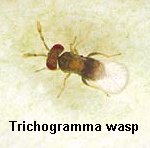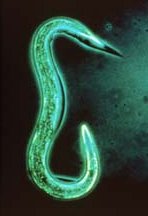 More about
More about
Insect Weed-eaters Just as predators and parasites may serve as effective biocontrol agents for insect pest populations, so insect herbivores have also proven effective as agents for controlling weed populations. Feeding injury by herbivores may weaken a plant or increase its susceptibility to disease, desiccation, freezing temperatures, or other herbivores. In any case, an injured plant is likely to be a poor competitor, and in time, beneficial species will have an opportunity to reclaim the vacated space.
Biological control is a particularly appealing pest control alternative because, unlike most other tactics, it does not always have to be reapplied each time a pest outbreak occurs. Once natural enemies are released into a new environment, there is a good chance they will become established and provide a self-perpetuating form of control. Biological control is also the only control tactic that increases, rather than decreases, the species diversity within an agroecosystem. This increased diversity often results in greater stability because wild fluctuations in population density are less common in communities with a diverse food web.
 Biological control is not a “quick fix” for most pest problems. Natural enemies usually take longer to suppress a pest population than other forms of pest control and farmers often regard this as a disadvantage. It also may be difficult to “integrate” natural enemies into a crop or commodity when pesticides are still in use. Beneficial insects are often highly sensitive to pesticides and their resurgence (recovery to pre-spray densities) is usually much slower than that of pest populations. Rapid pest resurgence often leads to a vicious cycle of continued chemical usage that prevents natural enemies from ever becoming reestablished.
Biological control is not a “quick fix” for most pest problems. Natural enemies usually take longer to suppress a pest population than other forms of pest control and farmers often regard this as a disadvantage. It also may be difficult to “integrate” natural enemies into a crop or commodity when pesticides are still in use. Beneficial insects are often highly sensitive to pesticides and their resurgence (recovery to pre-spray densities) is usually much slower than that of pest populations. Rapid pest resurgence often leads to a vicious cycle of continued chemical usage that prevents natural enemies from ever becoming reestablished.
Perhaps the greatest potential for future progress in biological control lies in improving the success of microbial pathogens. Many of these organisms are highly desirable as biocontrol agents: they attack a narrow range of insect hosts, they are not hazardous to humans or domestic animals, and they do not pose a threat to the environment. As a group, though, pathogens have never proven to be quite as reliable as other forms of pest control. They are vulnerable to desiccation, ultraviolet radiation, and high temperatures. They may not survive long enough in the environment to encounter a host, and even if they survive, their virulence may be too low to overcome the host’s defenses.
Examples of
Microbial
InsecticidesIn the past few years, however, there has been encouraging progress in the development of microbial insecticides. These are commercial suspensions of spores, toxins, or virus particles that can be mixed with water and sprayed onto crops just like conventional insecticides (see Table 2). In many cases, microbial insecticides are better than conventional insecticides because they suppress pest populations without eliminating natural populations of predators and parasites.
A great deal of research is still needed before we can begin to benefit from the full potential of biocontrol. Fortunately, new developments in biotechnology may soon enable us to create new strains of microbial pathogens that are more virulent, easier to mass produce, and less sensitive to temperature and humidity. Work is currently underway to transform a common soil microbe, Pseudomonas fluorescens, into a pathogen of soil-dwelling insects by implanting the delta-endotoxin gene from Bacillus thuringiensis. Clearly, there are major changes in biocontrol that lie just over the horizon.
 Natural control strategies that employ biological agents for pest suppression are generally classified as biological control tactics. In conventional usage, this term usually refers to the practice of rearing and releasing natural enemies: parasites, predators, or pathogens. A slightly broader definition of “biocontrol” includes any related management activity that is designed to protect or conserve natural enemies.
Natural control strategies that employ biological agents for pest suppression are generally classified as biological control tactics. In conventional usage, this term usually refers to the practice of rearing and releasing natural enemies: parasites, predators, or pathogens. A slightly broader definition of “biocontrol” includes any related management activity that is designed to protect or conserve natural enemies.



 Biological control is not a “quick fix” for most pest problems. Natural enemies usually take longer to suppress a pest population than other forms of pest control and farmers often regard this as a disadvantage. It also may be difficult to “integrate” natural enemies into a crop or commodity when pesticides are still in use. Beneficial insects are often highly sensitive to pesticides and their resurgence (recovery to pre-spray densities) is usually much slower than that of pest populations. Rapid pest resurgence often leads to a vicious cycle of continued chemical usage that prevents natural enemies from ever becoming reestablished.
Biological control is not a “quick fix” for most pest problems. Natural enemies usually take longer to suppress a pest population than other forms of pest control and farmers often regard this as a disadvantage. It also may be difficult to “integrate” natural enemies into a crop or commodity when pesticides are still in use. Beneficial insects are often highly sensitive to pesticides and their resurgence (recovery to pre-spray densities) is usually much slower than that of pest populations. Rapid pest resurgence often leads to a vicious cycle of continued chemical usage that prevents natural enemies from ever becoming reestablished.